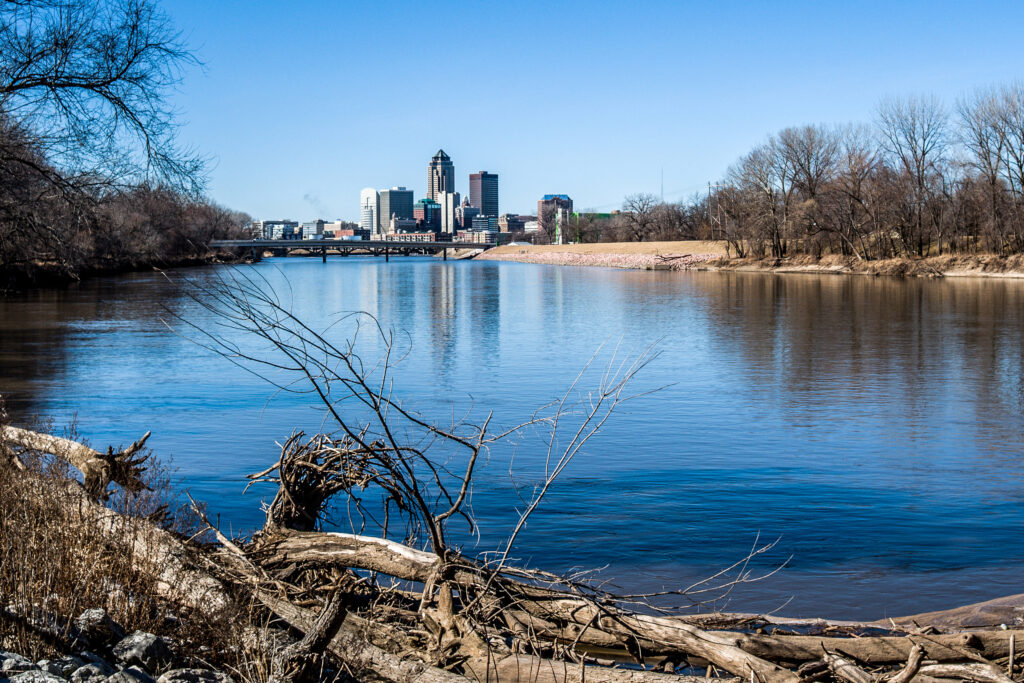Des Moines, Iowa, is a sprawling metro area of 740,000 people surrounded by agricultural operations. In Iowa, where hogs outnumber humans 7 to 1 and corn and soybean fields seem to stretch as far as the eye can see, Des Moines is at the heart of it all.
Though very few people in Des Moines are farmers—fewer than 5% of Iowans are—the area, which is situated on the banks of the Des Moines River, is the nexus of downstream agricultural pollution. The Des Moines Water Works (DMWW), which supplies water to approximately 600,000 people, is too.
On Oct. 29, 23 groups from five U.S. states penned a letter to EPA acting assistant administrator of water Bruno Pigott calling for federal intervention into a safe drinking water crisis with nitrate pollution at the center. Nitrates are the result of a chemical reaction in soil—ammonia-based fertilizer oxidizes nitrogen in soil, converting it into nitrate. Most farmers use a calculator to determine how much fertilizer to use, but most apply more than that as insurance, knowing that some may be lost to rain or other events. When fertilizer is over-applied, as it is by approximately 70 percent of farmers, whatever is not absorbed by the plants and the soil leaks into aquifers as nitrate.
In children, exposure to nitrate can cause a blood condition called methemoglobinemia, also known as blue baby syndrome. Exposure to nitrate as an adult is potentially associated with certain cancers and other health issues.
“Nitrate contamination and the harm it poses to human health demands a national approach and response in light of the growing prevalence of the problem and the patchwork of ineffective state strategies,” the letter states.
In 1992, construction was completed on the world’s largest nitrate-removal facility, located at DMWW, which still operates today. The EPA has a 10 parts per million (10 mg/L) limit for nitrate in drinking water. To meet this requirement, when the rivers from which Des Moines sources its water measure too high in nitrate, DMWW runs the facility. For many years, DMWW has turned the facility on and off based on nitrate levels. But this year featured many moments of steady rain, causing soil to become saturated and less absorbent, and the facility was up and running for two months straight, at a cost of anywhere from $10,000 to $16,000 per day. The cost of running this facility falls fully on ratepayers.
“The costs of excess fertilizer are being externalized on to Des Moines Water Works customers,” said Iowa Environmental Council (IEC) staff attorney Michael Schmidt.
In 2015, DMWW sued three counties for damages to the water supply from agricultural pollution. The state dismissed the suit because the counties would not have been able to redress the injuries DMWW cited in the suit. In 2021, Iowa Citizens for Community Improvement and Food & Water Watch also filed a suit alleging that the state violated public trust by failing to protect the cleanliness of the Raccoon River, a tributary of the Des Moines River, from which the DMWW sources drinking water. The state supreme court struck it down.
Since the 1990s, when DMWW first violated the nitrate drinking water standard, it has been a utility company with an advocacy bent, calling for upstream changes to change the downstream effects on the water. As the climate changes, extreme weather events could cause more runoff and, as a result, elevated nitrate concentrations.
“As we see these weather events become more extreme, we get these spells where it’s really dry and then really wet, and we see this sort of whiplash from dryness to deluge,” said Chris Jones, a former research engineer at IIHR—Hydroscience & Engineering at the University of Iowa, and author of The Swine Republic. “In the deluge portion of that, the nitrate tends to be worse than what it would be otherwise.”
Nitrogen pollution that begins in Iowa can cause algae blooms in watersheds from the Raccoon River to the Gulf of Mexico. As the population of metro Des Moines increases and water policy remains stagnant in the state, some advocates wonder if the water utility can keep up.
Downstream Effects
The Des Moines River begins in southwestern Minnesota, flows southeast to the city of Des Moines and then empties into the Mississippi River in the southeast corner of Iowa. The river cuts through the heart of the Corn Belt, passing highly industrialized farms and agricultural operations.
Farms in Iowa have been the subject of multiple lawsuits and widespread criticism over clean water throughout the past few years. This summer, the Des Moines Register editorial board published an editorial titled “Disastrous figures show the poverty of Iowa’s water quality approach.”
The piece calls attention to the Nutrient Reduction Strategy (NRS), a voluntary program the state implemented in 2013 aimed at reducing pollution in local waterways.
Eleven years later, the NRS has had little impact. According to Schmidt, of the Iowa Environmental Council, water pollution in Iowa is likely getting worse because the federal Clean Water Act does not apply to all agricultural runoff.
“The Clean Water Act is very good at reducing pollution from point sources, but for non-point sources, like row crop agriculture, the Clean Water Act has proven not to be a sufficient tool. Because of that, we end up with increasing nitrate loads that are not going down as the nutrient reduction strategy calls for,” he said.
DMWW primarily sources its drinking water from the Raccoon River and the Des Moines River. To alleviate the amount of nitrate concentrations in their water, in the early 2000s DMWW opened two new treatment plants and began tapping into other aquifers. They are even storing cleaner water underground to blend with water when nitrate concentrations get too high.
This story is funded by readers like you.
Our nonprofit newsroom provides award-winning climate coverage free of charge and advertising. We rely on donations from readers like you to keep going. Please donate now to support our work.
DMWW Chief Operating Officer Ted Corrigan explained that much of the work DMWW is doing to manage its nitrate problem involves working with and educating farmers. DMWW is partnering with an agricultural co-op and even helped them purchase equipment to plant cover crops in the Raccoon River watershed, which would ideally create cleaner water downstream.
“When I got into this work 35 years ago, I was an engineer and I was going to build things,” he said. “It never occurred to me that I would be doing anything of this kind.”
Clean Water as a Human Right
Iowa has the fastest-rising rate of cancer incidence in the U.S. Some advocates believe this is linked to the quality of the water.
“I think there’s a reckoning here by Iowans that something is wrong, that doesn’t correlate with our self-image of Iowans being robust, healthy and leading the nation,” said attorney James Larew, who recently co-founded the Iowa water advocacy group Driftless Water Defenders with Jones. “Now to be at the bottom of this horrible statistic, I think there’s a reawakening.”
Legally, 2024 has been a big year of action to protect water in Iowa. In February, state Rep. Art Staed introduced the “Clean Water for Iowa Act,” which tightens regulation on discharges from concentrated animal feeding operations, or CAFOs. In April, IEC petitioned the EPA to intervene in the nitrate crisis in the northeast corner of the state. The bill has not moved forward, and EPA has yet to reply to IEC, though a response is anticipated to arrive in November, Schmidt said.
Larew and Jones also recently proposed an amendment to Iowa’s constitution. Their group proposes amending Section 1, Article 1, which guarantees “all men and women … certain inalienable rights,” to include the “right to access clean water and clean air.”
“I think there’s a reckoning here by Iowans that something is wrong, that doesn’t correlate with our self-image of Iowans being robust, healthy and leading the nation.”
— James Larew, Driftless Water Defenders
“The state has an affirmative duty to protect natural resources, not only for this generation, but for all generations,” Larew said. “When it’s in the Constitution, it empowers citizens to challenge the state for insufficiently protecting this fundamental right to access to clean water.”
Back in Des Moines, Corrigan reiterated that things need to change in Iowa for Des Moines to keep providing residents with safe drinking water. In addition to expanding the production and treatment capability of DMWW, the trajectory of water quality in the state needs to change, he told Inside Climate News.
“We shouldn’t just continue to let things go into the water and assume that whoever needs to use the water downstream is just going to clean it up as much as they need to. We can’t just endlessly pollute,” Corrigan said. “I truly believe there’s a way for us to do both—to have profitable agricultural production and also clean water. And I don’t think those two are mutually exclusive. I think we just have to find a way to help them coexist.”
About This Story
Perhaps you noticed: This story, like all the news we publish, is free to read. That’s because Inside Climate News is a 501c3 nonprofit organization. We do not charge a subscription fee, lock our news behind a paywall, or clutter our website with ads. We make our news on climate and the environment freely available to you and anyone who wants it.
That’s not all. We also share our news for free with scores of other media organizations around the country. Many of them can’t afford to do environmental journalism of their own. We’ve built bureaus from coast to coast to report local stories, collaborate with local newsrooms and co-publish articles so that this vital work is shared as widely as possible.
Two of us launched ICN in 2007. Six years later we earned a Pulitzer Prize for National Reporting, and now we run the oldest and largest dedicated climate newsroom in the nation. We tell the story in all its complexity. We hold polluters accountable. We expose environmental injustice. We debunk misinformation. We scrutinize solutions and inspire action.
Donations from readers like you fund every aspect of what we do. If you don’t already, will you support our ongoing work, our reporting on the biggest crisis facing our planet, and help us reach even more readers in more places?
Please take a moment to make a tax-deductible donation. Every one of them makes a difference.
Thank you,




